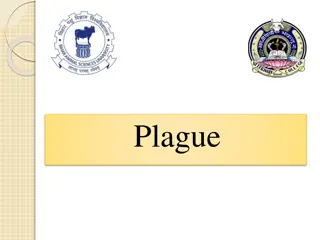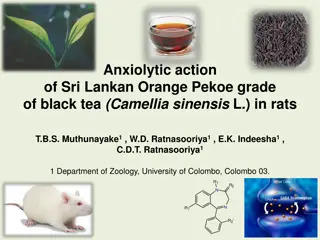Yersinia Pestis: The Bacterium Behind the Black Death
Yersinia pestis, the causative agent of the infamous Black Death, is a Gram-negative coccobacilli bacterium. It is transmitted through fleas and affects lymph nodes, causing bubonic plague. This article explores its general characteristics, pathogenesis, virulence factors, laboratory diagnosis, and treatment options. Learn about this deadly pathogen and its impact on history and medicine.
Download Presentation

Please find below an Image/Link to download the presentation.
The content on the website is provided AS IS for your information and personal use only. It may not be sold, licensed, or shared on other websites without obtaining consent from the author.If you encounter any issues during the download, it is possible that the publisher has removed the file from their server.
You are allowed to download the files provided on this website for personal or commercial use, subject to the condition that they are used lawfully. All files are the property of their respective owners.
The content on the website is provided AS IS for your information and personal use only. It may not be sold, licensed, or shared on other websites without obtaining consent from the author.
E N D
Presentation Transcript
Yersinia Dr . Salma
Yersinia pestis Black death 97241Asm
taxonomy Member of the Enterobacteriaceae family yersinia is gram nagative coccobacilli
Yersinia General characteristics: - Yersinia pestis is the causative agents of plague (the Black Death), and another two less important species: Yersinia enterocoltitica & Y. pseudo tuberculosis. - It is a small Gram ve bacilli, with bipolar staining with clear central area. - Freshly isolated organisms possess a capsule composed of polysaccharide-protein complex, where it is considered as virulence factor, where its loss leads to loss virulence. - It is considered as the virulent most bacteria known, where only 1-10 bacteria are capable of causing the disease. - Wild rodents are the animal reservoir, where it is endemic now in western U.S.A and in South East Asia.
Pathogenesis: - The vector is the wild rodent s fleas. Dogs could as the main reservoir, and human is the accidental host. - The organisms inoculated by the flea bite are spread to the regional lymph nodes which become swollen and tender (buboes), bubonic plague. - Organisms reach high concentration in the blood lead to abscesses in different organs, and the endotoxins relayed symptoms, such as disseminated intravascular coagulation, and Cutaneous hemorrhage gives the name of Black Death.
The virulence factors include: * The capsular antigens F-1 * The cell wall endotoxic * An exotoxin (its action is unknown) * V & W antigens (protect organisms from intracellular killing and digestion) * Yops (Yersinia Outer Proteins), experimentally shown to inhibit phagocytosis and cytokine production, as well as inhibit tumor necrosis factor production. Laboratory diagnosis: * Smear and culture from the blood or bubo is the best diagnostic test. * Great care must be taken during samplings. *Giemsa stain shows safety pin cell appearance. * For further diagnosis, fluorescent-antibody staining is used. Treatment: Combination of erythromycin and tetracycline is used without waiting the result to appear.
Target tissues This disease direct effects the lymph node which can be found in the groin , neck , and armpits cause them to enlarge and suppurate
Symptoms Bubonic Plague bacteria infect lymph nodes Bubos Fever Headache Vomiting Blood
Diagnostic Tests Take smear from blood or feces for bubonic plague > bacteria has safety pin appearance Can also use FA (fluorescent-antibody) test All plague bacilli have unique diagnostic envelope glycoprotein called the Fraction 1 (F1) antigen
Epidemiology: Transmission Bubonic Infected Rodent Fleas Humans Can also enter through breaks in skin when handling infected animal
Other Yersinia cause disease. Yersinia enterocolitica Typically, only a small number of human cases of Yersiniosis are recognized. Symptoms are like that of appendicitis and out breaks are often detected by a sudden increase in appendectomies in a particular region. The Center for Disease Control & Prevention estimates that about 17,000 cases occur each year in the United States.
Mortality Bubonic Plague Untreated 50- 60% mortality rate Treated 5 20% mortality rate Killed one third of the world s population during the 14th century Latest reports As of 15 March 2001, World Health Organization has reported a total of 436 suspected cases, including 11 deaths in Nyanje area in Zambia. As of 27 May 2002, the Malawian Ministry of Health has reported a total of 71 cases of bubonic plague in Malawi.
EVOLUTION: A single gene change in a relatively benign recent ancestor of the bacterium that causes bubonic plague played a key role in the evolution of the deadly disease from a germ that causes a mild human stomach illness acquired via contaminated food or water to the flea- borne agent of the "Black Death. GENETICS: Research on three genes, hemin storage (hms) genes, in Y. pestis that change it from a harmless, long-term inhabitant in the flea midgut to one that amasses in its foregut. PREVENTION: Current prevention measures include dusting family pets with insecticides to prevent the spread of the Yersinia pestis organism from the native prairie dog populations
Francisella Francisella tularensis, the causative agent of Tularemia. Small Gram ve bacilli with a single serologic type. Pathogenesis: - It is enzootic, isolated from more than 100 different species of wild animals, mainly rabbits, deer, and a variety of rodents. - The vectors are: ticks, mites and lice, where ticks can pass it to their offspring. - Human acquire the infection by a tick bite or due a direct contact with the animal during removal of the hide. - No person to person transmission. - Rarely transmitted by ingestion or inhalation causing gastrointestinal or pneumonic tularemia respectively. - Clinical findings, vary from sudden influenza- like syndrome to prolonged onset of a low grade fever and adenopathy, and may be other gastrointestinal and typhoid symptoms. Disease usually confers a lifelong immunity.
Laboratory diagnosis: It is very risky dealing with this organism. Media should contain cystcine. The best diagnostic tests are: 1-agglutination test and 2-fluorescent- antibody staining test of the infected tissues.
Pasteurella *Pasteurella multocida causes wound infections associated with cat and dogs bites. * It is short Gram ve, encapsulated with bipolar staining. * 25% of these animal bites will transmit these organisms with other anaerobic and facultative anaerobes present in the mouth. * The capsule and the endotoxins are considered as the virulence factors * The incubation period is less than 24 hrs. * Rapidly spreading cellulites at the site of the animal bite is an indicative of the P.multocida. * Osteomyelitis may complicate cat bite. * Laboratory diagnosis is binding the organism in culture of wound sample. * Penicillin G is the drug of choice.























